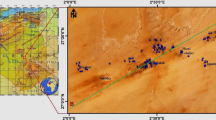Abstract
The overexploitation of groundwater in some parts of the country induces water quality degradation. The untreated industrial effluents discharged on the surface causes severe groundwater pollution in the industrial belt of the country. This poses a problem of supply of hazard free drinking water in the rural parts of the country. There are about 80 tanneries operating in and around Dindigul town in upper Kodaganar river basin, Tamilnadu, India. The untreated effluents from the tanneries have considerably affected the quality of groundwater in this area. To assess the extent of groundwater deterioration, a detailed analysis of groundwater quality data has been carried out. The concentration of cations such as Calcium (Ca2+), Magnesium (Mg2+), Sodium (Na+) and Potassium (K+), and anions such as Bicarbonate (HCO −3 ), Sulphate (SO 2−4 ), Chloride (Cl−) and Nitrate (NO3−) in the groundwater have been studied. Apart from these constituents, pH, electrical conductivity (EC), total dissolved solid and total hardness (TH as CaCO3) were also studied. The correlation of these constituents with the EC has been carried out. The highest correlation is observed between EC and chloride with a correlation coefficient of 0.99. Progressive reduction in correlation coefficients for Mg2+, (Na+ + K+), Ca2+ and SO 2−4 are observed as 0.91, 0.87, 0.86 and 0.56, respectively. It is found that the quality of groundwater in the area under investigation is deteriorated mainly due to extensive use of salt in the leather industries.






Similar content being viewed by others
References
APHA (1985) Standard methods for the examination of water and waste, 16th edition. APHA, Washington DC, pp 1–50
Balasubrahmanian K (1980) Geology of parts of Vedasandur Taluk, Madurai District, Tamilnadu. Progress Report, GSI Tech. Rept. Madras p14
Barker RD, Rao TV, Thangarajan M (2001) Delineation of contaminant zone through electrical imaging technique. Cur Sci 81(3):101–107
Bhaskaran TR (1977) Treatment and disposal of tannery effluents. Central Leather Research Institute (CLRI), Madras
Brown E, Skougstad, Fishman MJ (1974) Method for collection and analysis of water samples for dissolved mineral and gasses. US Govt. printing Washington, pp 1–160
Central Leather Research Institute (1990) Report on capacity utilization and scope for modernization in Indian tanning industry. Central Leather Research Institute, Madras pp 12
Chakrapani R, Manickyan PM (1988) Groundwater resources and developmental potential of Anna District, Tamilnadu State. Central Ground Water Board (CGWB), Rept., Southern Region, Hyderabad, pp 49
Davis SN, DeWiest RJM (1966) Hydrogeology. Wiley, New York, pp 463
Freeze RA, Cherry JA (1979) Groundwater. Prentice Hall Inc, Englewood Cliffs, pp 604
Mondal NC, Singh VS (2003a) Hydrogeological, geophysical and hydrochemical studies for delineating groundwater contamination zones in the tannery belt, Tamilnadu, India. In: Vijay P. Singh, Ram Narayam Yadava (eds) Proceedings of International Conference (WE-2003, Bhopal) on water and environment, ground water pollution. Allied Publishers Pvt. Ltd., pp 262–277
Mondal NC, Singh VS (2003b) Aquifer modeling study in and around Dindigul town, Tamilnadu, India. In: Vijay P. Singh, Ram Narayam Yadava (eds) Proceedings of International Conference (WE-2003, Bhopal) on water and environment, ground water pollution. Allied Publishers Pvt. Ltd., pp 188–198
Mondal NC, Singh VS (2004a) A new approach to delineate the groundwater recharge zone in hard rock terrain. Cur Sci 87(5):658–662
Mondal NC, Singh VS (2004b) Integrated approach to delineate the contaminated groundwater in the tannery belt: a case study. In: Proceeding of the 2nd Asia Pacific Association of Hydrology and Water Resources Conference, 5–9th July, 2004, Suntec, Singapore, Vol. II, pp 436–444
Mondal NC, Singh VS (2004c) Analysis of unconfined aquifer response to delineate potential groundwater recharge zone in hard rock terrain. In: Proceeding of the 2nd Asia Pacific Association of Hydrology and Water Resources Conference, 5–9th July, 2004, Suntec, Singapore, Vol. II, pp 445–452
Mondal NC, Singh VS, Sarma MRK, Thangarajan M (2002a) Impact of tannery effluent in groundwater and its control: a case study in and around Dindigul, Tamilnadu, India. Pro. of ICHWM-2002, BS Publisher, Vol. II, pp 596–604
Mondal NC, Thangarajan M, Singh V S (2002b) Application of cross-correlation technique to recharge zone due to rainfall in Kodaganar river basin, Tamilnadu, India. J Appl Hydrol XV(4):54–61
Paul Basker J (2000a) Tanneries in Dindigul District, Dossier on Tannery pollution in Tamilnadu. Peace Trust, Dindigul, Tamilnadu, India, pp 208–210
Paul Basker J (2000b) Tannery pollution and its effect on peoples life in Dindigul area, Dossier on Tannery pollution in Tamilnadu. Peace Trust, Dindigul, Tamilnadu, India, pp 195–197
Peace Trust (2000) Dossier on tannery pollution in Tamilnadu. Peace Trust, Dindigul, Tamilnadu, India, pp 280
Public Works Department (PWD) (2000) Groundwater perspectives, a profile of Dindigul District, Tamilnadu, Chennai, January 2000. Chennai, Tamilnadu, India, p 102
Singh VS, Mondal NC, Ron Barker, Thangarajan M, Rao TV, Subrahmanyam K (2003) Assessment of groundwater regime in Kodaganar river basin (Dindigul District, Tamilnadu). unpublished Tech.Report. No.2003-GW-269, p 104
Thangarajan M, Singh VS (1998) Estimation of parameters of an extensive aquifer—a case study. J Geol Soc India 52:477–481
World Health Organization (WHO) (1984) Guideline of drinking quality. WHO. Washington DC, pp 333–335
Acknowledgements
The authors thank Dr V.P. Dimri, Director, NGRI, for permitting to publish this paper. First author (N.C. Mondal) is also grateful to the Council of Scientific and Industrial Research (CSIR), New Delhi for their financial support to carry out this work.
Author information
Authors and Affiliations
Corresponding author
Rights and permissions
About this article
Cite this article
Mondal, N.C., Saxena, V.K. & Singh, V.S. Assessment of groundwater pollution due to tannery industries in and around Dindigul, Tamilnadu, India. Environ Geol 48, 149–157 (2005). https://doi.org/10.1007/s00254-005-1244-z
Received:
Accepted:
Published:
Issue Date:
DOI: https://doi.org/10.1007/s00254-005-1244-z




